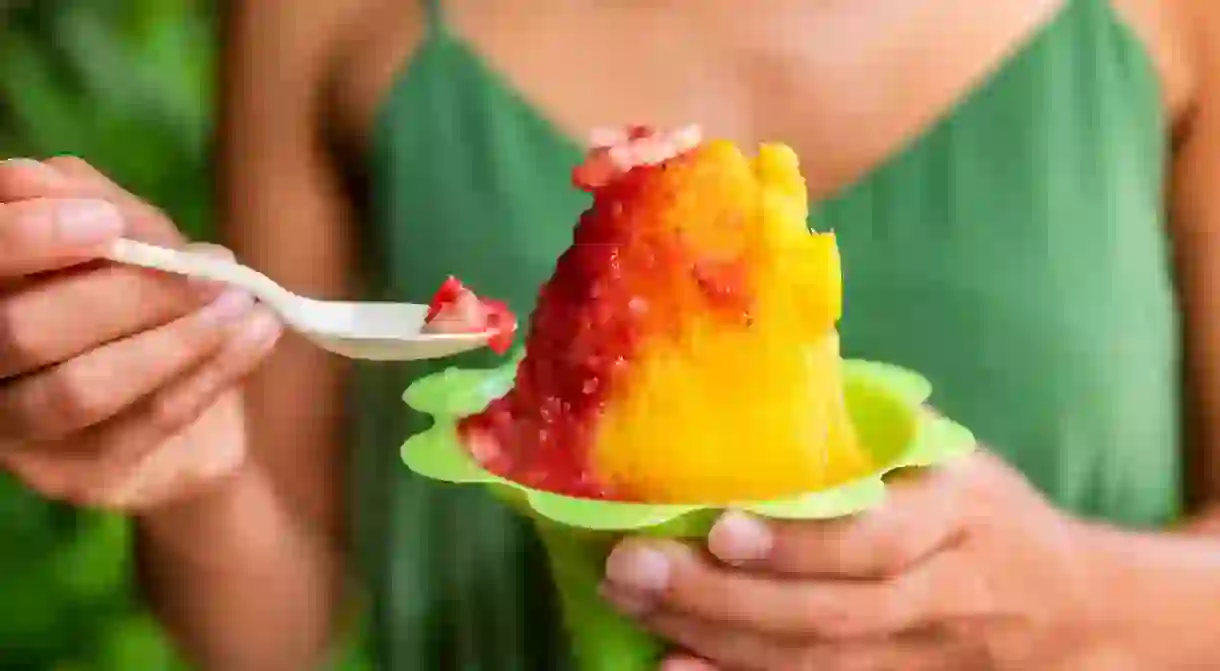These Are Hawaii’s Best Tropical Fruits

Nothing excites a Hawaii local like seeing fresh fruit weighing down their generations-old backyard tree.
But of course, most don’t have the luxury—or generous neighbors—so the next best thing is to hit up a neighborhood farmer’s market or stop by a local fruit seller on the side of the road. From açaí bowls, shave ice and smoothies to local desserts, Hawaii‘s delicious tropical fruits brighten up even the cloudiest of beach days (yes, there are some in Hawaii). If you’re visiting the Aloha State, make sure not to pass up a taste of these six tropical fruits.
Mango
Locals eagerly await mango season when those without a tree will likely harass their neighbors and friends for fruit. There are over 60 types of mangoes in Hawaii—all of which have slightly different flavors—but the most popular varieties are Rapoza, Haden, and Pirie. Hawaii‘s mangoes are truly unbeatable. They’re juicy with a flavor like no other and are best eaten fresh and ice cold. Mangoes are also used as toppings for desserts or to make the typical crack seed treat, pickled mango.

Star fruit
This curious-looking yellow fruit can be found at farmers markets throughout the islands. When cut in a cross section, the fruit creates a perfect star shape, making it a great garnish. The entire fruit is edible—sans seeds and stem—and has a sweet yet tart and crunchy flesh.

Strawberry guava
Very similar to the common guava which is also plentiful in Hawaii, waiawī (strawberry guava) is red and much smaller, yet tastes like you may imagine—a guava with hints of strawberry. Although extremely tasty, this tree is a highly invasive species from South America that threatens native Hawaiian forests. Each tree can produce hundreds of fruits at one time, so locals like to use them for juice, jelly, and cakes.
Lilikoʻi
Lilikoʻi (passion fruit) is an island favorite and used to flavor everything from açaí bowls, syrups, and jam, to freshly-squeezed smoothies and juice. The most popular use—and also a great gift—is lilikoʻi butter, perfect for toast, pancakes, or waffles, and often drizzled over yogurt or açaí bowls. The fruit is abundant throughout the islands and can be found growing wild. What most people don’t know is that the uglier and more wrinkled the fruit is on the outside, the better it is on the inside. It’s easy to spot ripe lilikoʻi fruit since the yellow color stands out among the green vines and trees.
Papaya
Papayas have a unique flavor that doesn’t suit everyone, but is packed full of vitamins—perfect for Hawaii‘s active lifestyle. Many people have a tree growing at home, but papayas can easily be found at any grocery store, farmer’s market, or sometimes even growing wild. When they turn from green to yellow, just pick one off the tree, scoop out the seeds, and enjoy.

Lychee
This prickly-looking red fruit seems right out of a sci-fi film, but is actually a plant originally from Asia. It was brought to Hawaii in the 1870s where it flourished in the island environment. Most lychees at the supermarket are imported since there are only a few commercial fields in Hawaii, so head to a farmer’s market or watch for vendors at the side of the road for some homegrown fruit. Once the lychees turn a bright red, peel away the outer shell and you’ll find a sweet, white, jelly-like interior with a single seed. If eating them fresh aren’t really your style, try a lychee martini or other cocktails that are very popular on the islands.
Did you know – Culture Trip now does bookable, small-group trips? Pick from authentic, immersive Epic Trips, compact and action-packed Mini Trips and sparkling, expansive Sailing Trips.













